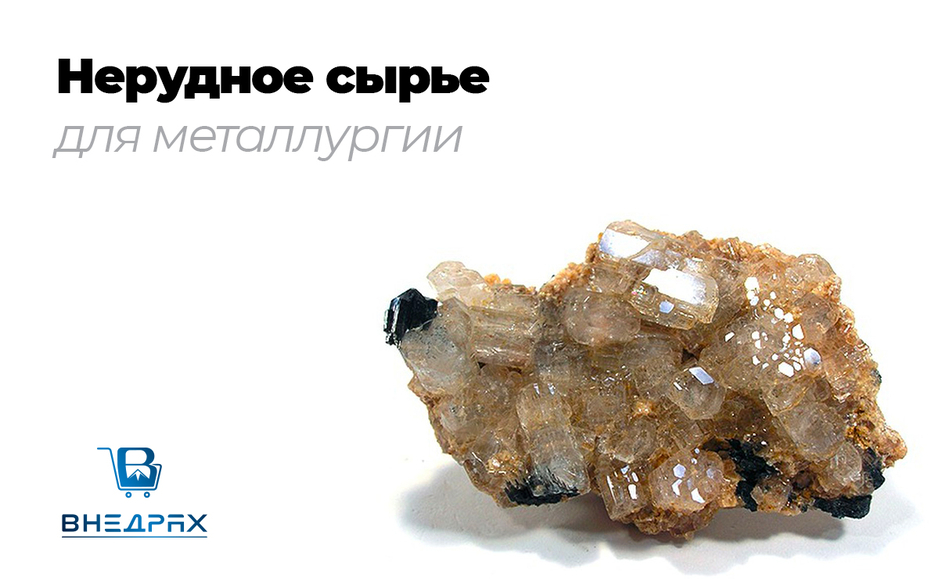Fluorspar
Purpose of fluorspar Brand Mass fraction of calcium fluoride, CaF2, no less Mass fraction of impurities, %, no more Silicon dioxide, SiO2 Calcium carbonate. CaCO3 Sulfur, S Phosphorus, P Welding fluorite FFS-95 95.0 3.0 2.0 0.1 0.03 Acid and ceramic fluorites FF-95A 95.0 2.0 1.5 0.2 – Fluorspar or Fluorite is a natural calcium fluoride (CaF2) with a theoretical calcium content of 51.33%, fluorine 48.67%. Chemically pure fluorspar is rare. It usually contains rare earths, uranium, gallium, beryllium and other rare elements, as well as organic substances, in small quantities. The color of fluorspar can be very diverse: the most characteristic are violet and green, less often blue, yellow, pink, green and violet stripes often alternate. Optical fluorite is colorless. The luster of fluorspar is glassy. Fluorite is translucent or transparent, dark varieties are translucent, less often opaque. Fluorspar is fragile. The cleavage of fluorite is perfect along the octahedron, cubic system. The shape of fluorspar crystals is cubes or octahedrons. Typically, fluorite forms dense or granular masses, or columnar and radial aggregates. In the 19th century in Great Britain, bluish-violet and green fluorite (Blue John, Green John) were widely used as decorative and semi-precious stones. During World War II, optical fluorite was a strategic raw material necessary for the manufacture of night vision devices. Today, more than half of all fluorspar is consumed in the chemical industry for the production of hydrofluoric acid (HF), from which fluorinated organic and inorganic substances are obtained, as well as artificial cryolite for the needs of the aluminum industry. The second largest consumer of fluorspar is the ferrous metallurgy, where it is used as a flux in smelting furnaces. In addition, fluorspar consumers are nuclear energy and the welding materials production industry. Fluorite occurs mainly as a vein mineral in association with calcite, barite, quartz, as well as sulfides of lead, zinc and other materials, less often in pegmatites. The mineral resource base for the production of fluorspar consists of deposits of fluorspar ores, which are mined using both underground and open-pit methods. Industrial mining of fluorspar is carried out practically from monomineral veins. In Russia, fluorspar is obtained from replacement deposits in limestones - in Primorye and Transbaikalia. The world's leading suppliers of fluorspar are Mexico, Mongolia, South Africa, Spain, China. There are also deposits of fluorite in France, Germany, and Great Britain. The main method of enrichment of fluorspar ores is flotation, and sometimes gravity. The technology for enriching fluorspar raw materials depends on the quality characteristics of the ore and the grade of the produced concentrates. Metallurgical grade fluorspar (CaF2 content 60-85%) is often produced by sorting high quality lump ore, followed by crushing and screening. Low-grade ore is enriched by gravity and separation. Often enriched ore serves as the starting product for further enrichment by flotation. Fluorspars of ceramic and acid grades are produced mainly by the flotation method. The technological scheme of beneficiation plants varies depending on the presence of undesirable impurities and associated minerals, such as barite, in the feedstock. Industry requirements for fluorspar are determined by GOST 29219-91, GOST 24626-81 and GOST 4421-73. The quality of fluorspar in each specific case is regulated by an agreement between the supplier (mine) and the enterprise or must comply with existing standards and technical specifications. Fluorspar, depending on production technology, physical and technological properties, CaF2 content and impurities, is divided into numerous types (grades) and grades. Fluorspar concentrate is divided into grades: acid, metallurgical and ceramic. For each grade of fluorspar there are requirements for the chemical composition: Content Type of fluorspar Acid Metallurgical Ceramic Fluorite, %, not less than 97 60 85-96 Silica, %, not less than 1.5 15 - Sulfide sulfur, %, not more than 0.1 0.3 - There is also another classification of fluorspar concentrates, dividing it into fluorite (ordinary), gravity and lump. In turn, each type of fluorspar is divided into grades depending on production technology, physical and mechanical properties, content of the main component and impurities. In the description of grades of fluorspar, the following designations are used: the first letter denotes fluorite concentrate, the second letter - type (K - lump, G - gravity, F - flotation), the third - C (welding), numbers indicate the percentage of calcium fluoride, letters A and B – respectively reduced or increased contentno phosphorus. Fluorspar is not magnetic and does not conduct electricity. Fluorspar is practically insoluble in water and completely decomposes in concentrated sulfuric acid, releasing hydrofluoric acid. Nitric and hydrochloric acid have little effect on it. Fluorspar is non-flammable, fire- and explosion-proof. In appearance, fluorspar is a yellow sand. Fluorspar is supplied in industrial packaging: NameName Weight, kg MKR 800-1500 kg Fluorspar is recommended to be transported and stored under the following conditions: fluorspar is transported by all available means of transport, in covered vehicles in accordance with the rules for the transportation of goods, fluorspar must be stored in original packaging, in closed warehouses. Protect fluorspar from contamination by foreign impurities. It is not allowed to mix different types of fluorspar concentrate. Subject to the conditions of transportation and storage in unopened original packaging, the guaranteed shelf life of fluorspar is not limited. Fluorspar is widely used in industry: fluorspar is used in the production of flux-cored wire, electrodes, welding fluxes for general and special purposes; in the metallurgical industry, fluorspar is used in the production of electrolytic aluminum; in ferrous metallurgy, fluorspar is used as a flux for liquefying slag in steel smelting , cast iron, production of special-purpose alloys, in the chemical industry, fluorspar is necessary for the production of fluoroplastics, refrigerants, hydrofluoric acid, fluoride salts, anhydrous hydrogen fluoride, in the glass industry, fluorspar is used in the production of heat-resistant glass pipes, glass beads, fiberglass, special optics, in A small amount of fluorspar is used in the production of cement, opaque white, and high-quality silicate enamels.
No reviews found



